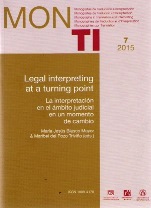Approaching the Bench: Teaching Magistrates and Judges how to Work Effectively with Interpreters
##plugins.themes.bootstrap3.article.main##
Resum
Descàrregues
##plugins.themes.bootstrap3.article.details##
La propietat intel·lectual dels articles pertany als autors i els drets d'edició i publicació, a la revista. Els articles publicats en la revista podran ser utilitzats lliurement per a propòsits educatius i científics, sempre que se'n faça una correcta citació. Qualsevol ús comercial és expressament penat per la llei.
Referències
Austin, John. (1962) How to do things with words. Oxford: Oxford University Press.
Berk-Seligson, Susan. (2008) “Judicial systems in contact. Access to justice and the right to interpreting/translating services among the Quichua of Ecuador.” Interpreting 10:1, pp. 9-33.
Berk-Seligson, Susan. (1990) The Bilingual Courtroom. Court interpreters in the judicial process. Chicago: The University of Chicago Press. Friedman-Rhodes, Elizabeth & Sandra Hale. (2010) “Teaching Medical Students to work with Interpreters.” The Journal of Specialised Translation 14, pp. 121-144.
Cook, Guy. (1989) Discourse. Oxford: Oxford University Press. Grice, Paul. (1975) “Logic and Conversation.” In: Cole, Peter & Jerry L. Morgan (eds.) 1975. Syntax and semantics. New York: Academic Press, vol. 3, pp. 41-58.
Hale, Sandra. (2014) “Interpreting culture. Dealing with cross-cultural issues in court interpreting.” Perspectives 22:3, pp. 321-331.
Hale, Sandra. (2013) “Helping interpreters to truly and faithfully interpret the evidence: The importance of briefing and preparation materials.” Australian Bar Review 37:3, pp. 307-320.
Hale, Sandra. (2011a) “The need to raise the bar: court interpreters as specialised experts.” The Judicial Review 10:2, pp. 237-258.
Hale, Sandra. (2011b) Interpreter policies, practices and protocols in Australian Courts and Tribunals. A national survey. Melbourne: Australian Institute of Judicial Administration.
Hale, Sandra. (2007) “The challenges of court interpreting: intricacies, responsibilities and ramifications.” Alternative Law Journal, 32:4, pp. 198-202.
Hale, Sandra. (2004) The discourse of court interpreting. Discourse practices of the law, the witness and the interpreter. Amsterdam & Philadelphia: John Benjamins.
Hale, Sandra. (2001) “The complexities of the bilingual courtroom.” Law Society Journal (July 2001), pp. 68-72.
Hale, Sandra & Ludimila Stern. (2011) “Interpreter quality and working conditions: comparing Australian and international courts of justice.” Judicial Officers’ Bulletin 23:9, pp. 75-81.
Hale, Sandra & Jemina Napier (forthcoming). “‘We’re just kind of there’: Working conditions and perceptions of appreciation and status in court interpreting” (Submitted, awaiting response).
Mikkelson, Holly. (2008) “Evolving views of the court interpreter’s role. Between Scylla and Charybdis.” In: Valero Garcés, Carmen & Anne Martin (eds.) 2008. Crossing borders in community interpreting. Definitions and dilemmas. Amsterdam & Philadelphia: John Benjamins, pp. 81-97.
Morris, Ruth. (2010) “Court Interpreting 2009: an undervalued and misunderstood profession? Or: will justice speak?” MonTI. Monografías de Traducción e Interpretación 2, pp. 47-79. Electronic version: http://rua.ua.es/dspace/bitstream/10045/16435/1/MonTI_2_04.pdf
Szldy & Ors vs Minister for Immigration & Anor [2008] FMCA 1684:16.
Wierzbicka, Anna. (2003/2009) Cross-Cultural Pragmatics. The Semantics of Human Interaction. Berlin & New York: De Gruyter Mouton.


